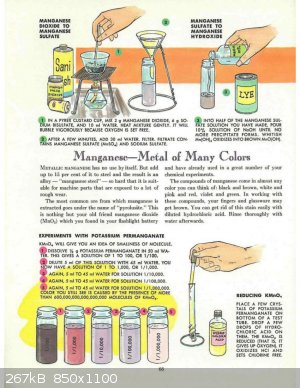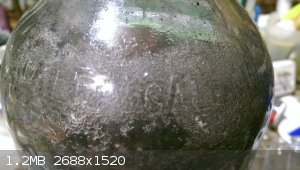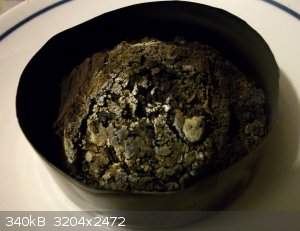CoolFool
Harmless

Posts: 10
Registered: 30-4-2016
Member Is Offline
Mood: No Mood
|
|
Use of MnO2
Is there a way by which I could extract Manganese from MnO2. If not can I make a useful compound or do some interesting experiment with it?
|
|
|
Bert
|
Thread Moved
22-12-2016 at 06:40 |
Derek McOlund
Harmless

Posts: 11
Registered: 28-11-2016
Member Is Offline
Mood: No Mood
|
|
Well, you can make MnSO4 using SO2 and MnO2. I think that you can replace the manganese in solution with aluminium. That way you should get a
precipitate of manganese metal. MnO2 can also be used to make sulphuric acid, I've recently made a video about that: https://www.youtube.com/watch?v=hr7jM7eOptc&t=2s hope you find it useful.
|
|
|
MrHomeScientist
International Hazard
    
Posts: 1806
Registered: 24-10-2010
Location: Flerovium
Member Is Offline
Mood: No Mood
|
|
I don't believe you can get elemental manganese with aqueous chemistry; it's too active. I've made it with manganese thermite before. It's hard to get
good quality metal this way, though, because manganese's boiling point is lower than aluminum oxide's melting point. So much of it either doesn't
separate into nice lumps or simply boils away during the reaction.
|
|
|
Zandins
Harmless

Posts: 25
Registered: 18-6-2016
Member Is Offline
Mood: No Mood
|
|
The first step would be to convert the MnO2 to a soluble Mn2+ salt.There are several methods.
1)You can use it to prepare chlorine gas in reaction with HCl:
MnO2 + 4HCl --> MnCl2 + Cl2 + 2HOH
2)You can convert it to MnSO4 with SO2, yet yields will be poor, and an efficient sulfur burner is not trivial to set up;
MnO2 + SO2 --> MnSO4
3)Manganse dioxide is reduced by hot, concentrated sulfuric acid:
2MnO2 + H2SO4 --> 2MnSO4 + O2 + H2O
Then, the manganse salt can be further processed to recover manganese.
1)A solution of manganese chloride can be electrolysed. In near-neutral medium, concentration of H+ ions is small and Mn precipitates on the cathode:
MnCl2 --> Mn + Cl2
2)Manganese sulphate can also be electrolysed, yet there will be a competing side-reaction on the anode:
2H2O --> O2 + 4H+ or Mn2+ + 2H2O --> MnO2 + 4H+
The actual outcome is dependant on the pH, T and other factors.
3)Mn can be displaced by a more active metal. Note however, that this metal must be finely ground, strong stirring must be employed, and the metal
must not passivate. For example, aluminium is difficult to use in such reactions, as it forms a protective layer of Al2O3.
Alternatively, you could reduce the MnO2 with coal(coke).
Zandins
|
|
|
MrHomeScientist
International Hazard
    
Posts: 1806
Registered: 24-10-2010
Location: Flerovium
Member Is Offline
Mood: No Mood
|
|
Do you have a reference for Mn formation in aqueous solution? I'd be interested to read it.
If aluminum passivation is an issue, a small amount of chloride in solution will take care of that.
|
|
|
Zandins
Harmless

Posts: 25
Registered: 18-6-2016
Member Is Offline
Mood: No Mood
|
|
Reference
The attached treatise examines the methods for production of manganese from pyrolusite ore, whose main constituent is MnO2. The section of
electrowinning starts at p.20.
Attachment: zhang2007.pdf (547kB)
This file has been downloaded 1165 times
|
|
|
awlb2
Harmless

Posts: 27
Registered: 21-11-2016
Member Is Offline
Mood: No Mood
|
|
If I remember correctly MnO2 can be made into MnSO4 safely by reacting with NaHSO4, then fractionally crystallizing the mixture of Na2SO4 and MnSO4
(MnSO4 is much more soluble that Na2SO4).
|
|
|
JJay
International Hazard
    
Posts: 3440
Registered: 15-10-2015
Member Is Offline
|
|
Quote: Originally posted by awlb2  | | If I remember correctly MnO2 can be made into MnSO4 safely by reacting with NaHSO4, then fractionally crystallizing the mixture of Na2SO4 and MnSO4
(MnSO4 is much more soluble that Na2SO4). |
Na2SO4 is extremely soluble in warm water but very insoluble in cold water... that's an interesting idea....
2 MnO2 + 4 NaHSO4 <=> 2 Na2SO4 + 2 MnSO4 + 2 H2O + O2
I'm a bit skeptical that this reaction actually takes place.
It's possible to calculate the Gibbs free energy to find out without actually attempting the reaction....
It's actually kind of hard to find good thermodynamics data on sodium bisulfate. The heat of solution and entropy of solution for the bisulfate ion
are found in this paper at around -4142 cal / mol and -22.9 cal / mol: http://pubs.acs.org/doi/pdf/10.1021/ic50080a031
This document lists the heat of formation of crystaline sodium bisulfate as -1125.5 kJ / mol and its entropy of formation as 113.0 J / (mol degK): http://www.update.uu.se/~jolkkonen/pdf/CRC_TD.pdf
I need a lot more data to do this calculation....
[Edited on 23-12-2016 by JJay]
|
|
|
dactyl
Unregistered
Posts: N/A
Registered: N/A
Member Is Offline
|
|
More on ammnonia-based electrolytic methods:
https://books.google.ca/books?id=kgGAVmMBQoEC&pg=PA110&a...
Advances in Chemical Enginneering Volume 9
|
|
|
awlb2
Harmless

Posts: 27
Registered: 21-11-2016
Member Is Offline
Mood: No Mood
|
|
Although a dubious source  the Golden Book of Chemistry Experiments (http://library.sciencemadness.org/library/books/Brent_GBC.pd...) shows the reaction of MnO2 and NaHSO4 as a viable way to
make MnSO4 even describing formation of oxygen gas and sodium sulfate as byproducts as expected - look on page 66. the Golden Book of Chemistry Experiments (http://library.sciencemadness.org/library/books/Brent_GBC.pd...) shows the reaction of MnO2 and NaHSO4 as a viable way to
make MnSO4 even describing formation of oxygen gas and sodium sulfate as byproducts as expected - look on page 66.
As the book suggests, precipitation of the Mn2+ as manganese hydroxide or carbonate is a better idea that fractional crystallization. What
Mn compound are you looking to make anyway?
[Edited on 23-12-2016 by awlb2]
|
|
|
JJay
International Hazard
    
Posts: 3440
Registered: 15-10-2015
Member Is Offline
|
|
Quote: Originally posted by awlb2  | Although a dubious source  the Golden Book of Chemistry Experiments (http://library.sciencemadness.org/library/books/Brent_GBC.pd...) shows the reaction of MnO2 and NaHSO4 as a viable way to
make MnSO4 even describing formation of oxygen gas and sodium sulfate as byproducts as expected - look on page 66. the Golden Book of Chemistry Experiments (http://library.sciencemadness.org/library/books/Brent_GBC.pd...) shows the reaction of MnO2 and NaHSO4 as a viable way to
make MnSO4 even describing formation of oxygen gas and sodium sulfate as byproducts as expected - look on page 66.
As the book suggests, precipitation of the Mn2+ as manganese hydroxide or carbonate is a better idea that fractional crystallization. What
Mn compound are you looking to make anyway?
[Edited on 23-12-2016 by awlb2] |
This looks much easier than the procedures posted by Nurdrage and on eHow. Precipitating manganese carbonate is a good idea... you could dissolve it
in most acids without generating nasty fumes.

|
|
|
violet sin
International Hazard
    
Posts: 1475
Registered: 2-9-2012
Location: Daydreaming of uraninite...
Member Is Offline
Mood: Good
|
|
Battery gunk MnO2 + MeOH + H2SO4 seemed pretty good from the start. There are a number of papers on this with at
least free abstract.
Reductive leaching of manganese oxide ore in aqueous methanol–sulphuric acid medium
https://www.researchgate.net/publication/223760585_Reductive...
Just the gunk/water slurry showed reaction w/ MeOH, a short lived chlorine smell and turned a touch turbid at the top.. Added sulfuric acid and
noticed things taking off nicely. No hotter than could be held by hand, small bubbles and a slow fizz. After some time I went back out to check on
it, the chlorine smell was gone and some clear crystals had started on the sides of my jug. Little patches branching out from nucleation points.
Fewer stout points radiating outward, but not all cottony like Iv'e seen before. Crap pictures this time
Basically just some fun while cleaning up some OLD projects. The battery gunk was from like 3+ years ago. Maybe as much as 5 yrs. Anyhow, have it
sitting over night and will check pH etc. tommorow. Already typed this crap up once, forgot and navigated away... Ugh....
1/2 gal jug, 1/4 gal water, 150ml~ MeOH, 6v MnO2 goop and perhaps 40-50ml sulfuric drain cleaner were roughed together in a few smaller
increments to be certain of safety for the initial starting mess.

|
|
|
awlb2
Harmless

Posts: 27
Registered: 21-11-2016
Member Is Offline
Mood: No Mood
|
|
What is the purpose of adding methanol exactly(I presume there is little iron contamination in battery MnO2)?
I had another idea on how to get Mn2+ from Mn(IV), simply reduce MnO2 with hydrogen gas or methane (or maybe carbon?) to get
manganese (II) oxide.
The manganese (II) oxide can then react with acids easily to form the corresponding Mn(II) salt.
MnO2 + H2-------> MnO + H2O
MnO + 2H"X"--------> Mn"X"2 + H2O
Thanks, Happy Christmas everyone!
[Edited on 23-12-2016 by awlb2]
|
|
|
violet sin
International Hazard
    
Posts: 1475
Registered: 2-9-2012
Location: Daydreaming of uraninite...
Member Is Offline
Mood: Good
|
|
MeOH is privided as oxygen a target. There are papers on its reduction by:
Glucose https://www.researchgate.net/publication/229185406_Reductive...
Cellulose http://www.zndxzk.com.cn/down/paperDown.aspx?id=2021725
These vent oxygen off productively so you dont get to breath chlorine or sulfer dioxide from your acid. Basically just add a waste product to burn up
and get your acid to work only on product Mn salt. This enables effective leaching of low grade ore with weak acid
|
|
|
wg48
National Hazard
   
Posts: 821
Registered: 21-11-2015
Member Is Offline
Mood: No Mood
|
|
While drying washed used battery gunk in a domestic microwave oven I discovered it absorbs microwaves very well. Not much a surprise as that’s
typical of many metal oxides.
With prolonged microwave heating the carbon is oxidised and the manganese oxides are reduced in particular the MnO2 The result is a light brown powder
containing much less carbon and MnO2. Its probably mostly Mn2O3 with lower oxides. Note if the gunk is from exhausted batteries it also contains
significant amounts of zinc oxide.
The light brown powder on standing in cold 32% sulphuric acid dissolves to produce a very intense ruby red coloured solution probably Mn(III) with
Mn(II). It also dissolves in the cold in acetic acid. No reducer is required. It’s the MnO2 that’s requires the reducer or concentrated acid and
heat.
I used a shallow stainless steel crucible to microwave the dried and powdered gunk. The heating was concentrated in the centre of the powder so it
must be stirred frequently to heat all parts of the powder. At full power for a minute or two the centre will glow brightly and melt. With less
heating the center glows a dull red with no melting.
With a suitable crucible and added carbon it may be possible to produce manganese metal from new battery gunk that is less contaminated with zinc.
|
|
|
violet sin
International Hazard
    
Posts: 1475
Registered: 2-9-2012
Location: Daydreaming of uraninite...
Member Is Offline
Mood: Good
|
|
Interesting microwave results, but it has me wondering if you could just mix in some sugar and nuke it in a porcelain dish or drinking glass... WELL
below red heat. Leach products with the acid of your choice. Though I see where you are going with op's desire to get the metal, I'm more
interested in the salts sans fumes.
|
|
|
exodia
Harmless

Posts: 25
Registered: 3-10-2016
Member Is Offline
Mood: No Mood
|
|
so I have been investigating this topic, and I stumbled upon this article from sciencedirect:
--Quote--
The reductive leaching of manganese oxide ore in aqueous methanol–sulphuric acid was investigated. Studies were conducted at low (30 and 70°C) and
high (120–170°C) temperatures, using different acid (0.005–0.30 M H2SO4) and methanol (0–50 vol%) concentrations. Results showed that
satisfactory levels of manganese extraction could be achieved during autoclave digestion at temperatures between 150 and 170°C with a reaction
mixture containing 20–40 vol% methanol at relatively low sulphuric acid concentrations of between 0.1 and 0.20 M. Conditions for optimum manganese
extraction are determined by the methanol and sulphuric acid concentrations as well as the reaction temperature. For example, manganese extraction of
about 98% was reached at 160°C with a methanol dosage of 40 vol% at 0.3 M sulphuric acid within a period of 2 h. Comparatively good extraction level
of 86% could be attained at lower methanol and acid concentrations of 20 vol% and 0.092 M respectively, but at a longer reaction time of 3 h. Particle
size seemed to have very little effect on extraction for sizes between 32 and 125 μm. An interesting feature of leaching in an aqueous
methanol–sulphuric acid medium is the apparent suppression of iron dissolution from the ore in the presence of methanol. For example at 120°C and
0.16 M sulphuric acid concentration iron extraction from the ore decreased from 58% at 0 vol% methanol addition to about 3.5% at 50 vol% methanol
concentration. At 160°C and 0.092 M acid concentration iron extraction was only 0.4% at 40 vol% methanol concentration.
--End of quote--
There is a full PDF but I couldn't download it, so why is there a reduction in the iron dissolution (that question may be resolved If I work out how
this works) I'm not too sure what kind of reaction is this.
MnO2 and H2SO4 react together nicely enough, what is the MeOH doing here, is it changing the overall reaction?
as far as I know: 2 MnO2 + 2 H2SO4 = 2 H2O + 2 MnSO4 + O2
were does the methanol fit in here?
|
|
|
j_sum1
Administrator
       
Posts: 6220
Registered: 4-10-2014
Location: Unmoved
Member Is Offline
Mood: Organised
|
|
I would say it is needed to reduce the Mn(II) to Mn.
Probably water and CO2 given off.
|
|
|
exodia
Harmless

Posts: 25
Registered: 3-10-2016
Member Is Offline
Mood: No Mood
|
|
If I'm not mistaken the H2SO4 is strong enough to get the Mn to Mn II, is an expontaneous reaction (maybe some heating needed)
|
|
|
violet sin
International Hazard
    
Posts: 1475
Registered: 2-9-2012
Location: Daydreaming of uraninite...
Member Is Offline
Mood: Good
|
|
MnO2 will chew up acid, oxidizing the Cl- to Cl2 (gas), SO2 for H2SO4 instead of going quietly.
Waste of acid when you give it something to eat instead.
MeOH + MnO2 + H2SO4 -> MnSO4 + oxidized alcohol (CO2 / H2O)
My first try ever, with no heating is a breeze. Added, left overnight, decanted, added more to the MnO2. Doubble filtered first run, left
second on bat gunk, to be filtered a replaced untill its gone from jar 1. 2 pulls have been made, on third now. Each removed solution was settled,
decanted and filtered before storage to be boiled down later. It is a nice clear sol. with white bits starting to form at the bottom. Looking clean
first try 
Family is in town so I dont have a back yard to boil stuff down. The guest bedroom faces the yard with one full wall, two windows and a glas door.
If im out there, they aint sleeping, means I am not going out there 
|
|
|
wg48
National Hazard
   
Posts: 821
Registered: 21-11-2015
Member Is Offline
Mood: No Mood
|
|
Quote: Originally posted by violet sin  | | Interesting microwave results, but it has me wondering if you could just mix in some sugar and nuke it in a porcelain dish or drinking glass... WELL
below red heat. Leach products with the acid of your choice. Though I see where you are going with op's desire to get the metal, I'm more
interested in the salts sans fumes. |
My first reaction to your suggestion was that it may well work at a slightly low temperature because the carbon formed will be more intimately mixed
with the Mn oxide but that may only mean dull red heat instead of red heat.
However thinking about it as the sugar decomposes at a temperature much lower than red heat the reducing decomposition products may well reduce the
MnO2. Though I suspect red heat will be required to completely decompose the sugar to insoluble products (carbon) that can be easily remove by
filtering after digestion with acid.
Perhaps a combination of sugar and sulphuric acid (of a suitable concentration) will reduce all the Mn (IV and III) to Mn(II) as the sulphate without
wasting part of the acid as a reducer and not producing SO2 gas.
Side note: the methanol method is interesting particularly if it produces Mn(II)
I decided to try the micro waving sugar and dried battery gunk. About 30 ml of a 2:1 by volume mixture of gunk and icing sugar in shallow steel can.
Initially lots of caramel smelling smoke then more smoke with a dull glow, then ignition with the appearance of a mild thermite reaction accompanied
by large smoky flames which subsided to yellow and blue flames. The blue flames looked like zinc burning as confirmed by white deposits on the can
and the inside of the oven. It was fullpower (800W) for about 450s.
The mixture is now a porous weak mass. If any manganese metal was produces it probably oxidised as the mass cooled. It needs to be performed in a
closed crucible to exclude air and insulated to have a chance of producing a nugget of manganese. It suggests the method has promise.

Mixing the above porous mass with 32% sulphuric produced some slight fizzing with a smell of hydrogen sulphide and a smell I associate with steel
dissolving in acid. I was not able to collect sufficent gas to test for hydrogen. Perhaps some Mn or zinc metal was left in the mass.
[Edited on 27-12-2016 by wg48]
[Edited on 27-12-2016 by wg48]
[Edited on 27-12-2016 by wg48]
|
|
|